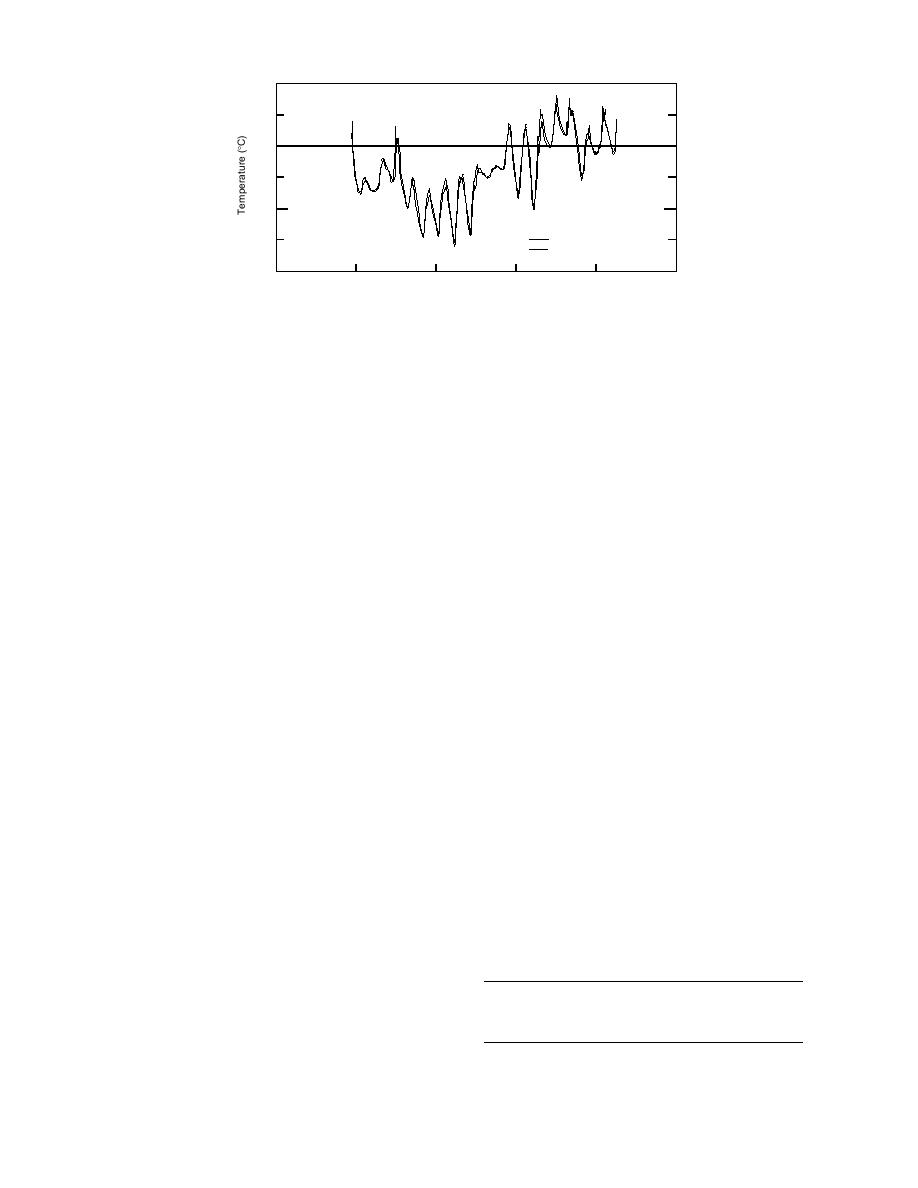
10
0
10
8.1 cm (3.2") into Wall
Surface
20
15
20
0
5
10
25
Time (days)
Figure 11. Temperature history of the EY-11 concrete wall placed at 12:05
p.m. on 18 Feb (day 2) at Hanover, New Hampshire. A malfunction of the
data recorder eliminated temperature records until 21 Feb (day 5).
3C (37F) when it came in contact with the cold
shows that the wall did not suffer frost damage.
ground but quickly rose to 13.2 C (55.8F) by 1:00
This was not a severe test of the low-tempera-
p.m. and then began to cool. A malfunction of the
ture capability of either admixture because the
temperature recorder prevented recordings from
ambient and concrete temperatures both were
18 Feb at 12:30 a.m. to 21 Feb at 4:30 p.m. Al-
above freezing.
though the air temperature during the first three
Strength. Results of the strength tests from the
nights got quite cold, 15 C (5F) at 6:30 a.m. on
field-cured pullout cylinders taken from each con-
the 18th (day 2), 10.3 C (13.5F) at 6 a.m. on the
crete section are presented in Table 26. Though
19th (day 3), and 5.4 C (22.3F) at 2 a.m. on the
no control concrete was cast at the site for direct
20th (day 4), the concrete did not freeze. A petro-
comparison to the pullout cylinder strength re-
graphic examination of core samples drilled from
sults, the strength of admixture-free concrete of
the concrete confirmed this. Data from a separate
similar mix design with a 0.44 w/c ratio cured at
project show that a slab placed next to this slab at
room temperature is given. As can be seen, the
9 a.m. on the same day dropped to a low of only
field samples exceeded the 28-day strength of the
1.2C (29.8F) on 19 Feb (day 3). This kind of
room-cured concrete. This is remarkable for the
temperature would not have damaged the
EY-11 owing to its relatively high w/c of 0.55.
Pozzutec 20 slab. The Pozzutec 20 slab cooled to
below 5C (23F) at 3 a.m. on the 26th (day 10),
Michigan
and remained below that temperature until 7 a.m.
Test site. The second field test was conducted
on 2 March, a five-day period. It then rose slowly
in northern Michigan in March 1994. The Corps`
the next seven days to near 0C (32F) on 10 March.
Soo Area Office had scheduled 39 sections of con-
Notice that the slab was close to uniform tem-
crete to be replaced because of their advanced
perature throughout the recording period. The
stage of freezethaw deterioration. The work area
three temperature recordings (two other thermo-
was located on the southwest pier, which borders
couples malfunctioned) nearly overlay one an-
the ship canal of the Poe Lock, the largest of four
other. Because of the closeness of the recorded
locks operated and maintained by the Corps of
temperatures, no attempt was made to distinguish
Engineers, Sault Ste. Marie, Michigan. Inspection
the significance of one line from another.
The wall with admixture EY-11 was placed on
Table 26. Strength results, MPa (psi), from pull-
18 Feb (day 2) at 12:05 p.m. at a concrete tempera-
ture of 16C (61F). Unfortunately, the recorder
out cylinders cast into the concrete.
malfunction prevented any temperature record
Mixture
7 days
28 days
until 21 Feb (day 4) at 4:30 p.m. Two temperature
histories, one on the surface and one internal tem-
Pozzutec 20
27.4 (3975)
48.3 (7010)
EY-11
20.3 (2949)
38.1 (5526)
perature, are plotted in Figure 11. A petrographic
Room-cured admixture-free
30.9 (4480)
37.6 (5451)
examination of core samples obtained in May
20



 Previous Page
Previous Page
